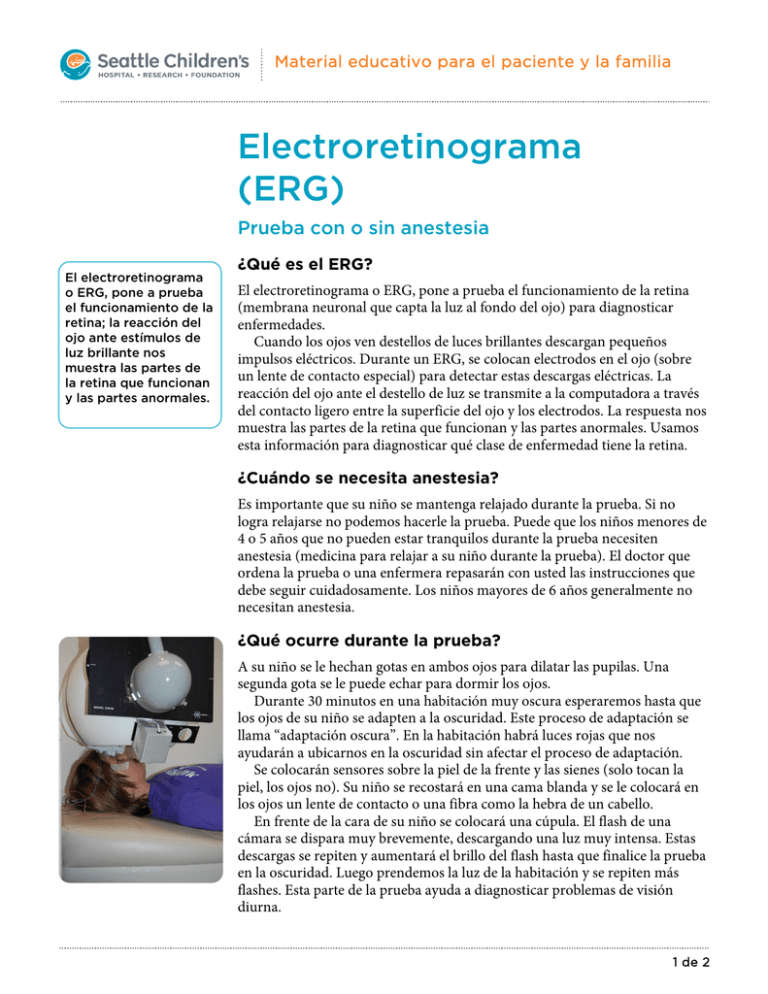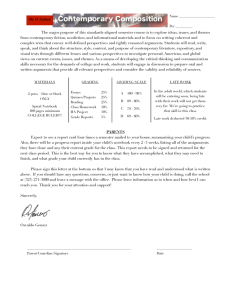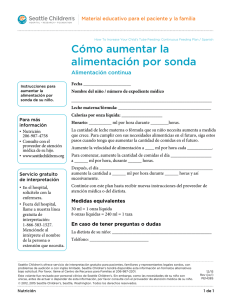ERG - Seattle Children`s Hospital
Anuncio

Material educativo para el paciente y la familia Electroretinograma (ERG) Prueba con o sin anestesia ¿Qué es el ERG? El electroretinograma o ERG, pone a prueba el funcionamiento de la retina; la reacción del ojo ante estímulos de luz brillante nos muestra las partes de la retina que funcionan y las partes anormales. El electroretinograma o ERG, pone a prueba el funcionamiento de la retina (membrana neuronal que capta la luz al fondo del ojo) para diagnosticar enfermedades. Cuando los ojos ven destellos de luces brillantes descargan pequeños impulsos eléctricos. Durante un ERG, se colocan electrodos en el ojo (sobre un lente de contacto especial) para detectar estas descargas eléctricas. La reacción del ojo ante el destello de luz se transmite a la computadora a través del contacto ligero entre la superficie del ojo y los electrodos. La respuesta nos muestra las partes de la retina que funcionan y las partes anormales. Usamos esta información para diagnosticar qué clase de enfermedad tiene la retina. ¿Cuándo se necesita anestesia? Es importante que su niño se mantenga relajado durante la prueba. Si no logra relajarse no podemos hacerle la prueba. Puede que los niños menores de 4 o 5 años que no pueden estar tranquilos durante la prueba necesiten anestesia (medicina para relajar a su niño durante la prueba). El doctor que ordena la prueba o una enfermera repasarán con usted las instrucciones que debe seguir cuidadosamente. Los niños mayores de 6 años generalmente no necesitan anestesia. ¿Qué ocurre durante la prueba? A su niño se le hechan gotas en ambos ojos para dilatar las pupilas. Una segunda gota se le puede echar para dormir los ojos. Durante 30 minutos en una habitación muy oscura esperaremos hasta que los ojos de su niño se adapten a la oscuridad. Este proceso de adaptación se llama “adaptación oscura”. En la habitación habrá luces rojas que nos ayudarán a ubicarnos en la oscuridad sin afectar el proceso de adaptación. Se colocarán sensores sobre la piel de la frente y las sienes (solo tocan la piel, los ojos no). Su niño se recostará en una cama blanda y se le colocará en los ojos un lente de contacto o una fibra como la hebra de un cabello. En frente de la cara de su niño se colocará una cúpula. El flash de una cámara se dispara muy brevemente, descargando una luz muy intensa. Estas descargas se repiten y aumentará el brillo del flash hasta que finalice la prueba en la oscuridad. Luego prendemos la luz de la habitación y se repiten más flashes. Esta parte de la prueba ayuda a diagnosticar problemas de visión diurna. 1 de 2 Electroretinograma (ERG) con o sin anestesia Para más información • Oftalmología 206-987-3567 • Consulte con el proveedor de atención médica de su hijo • www.seattlechildrens.org ¿Cuánto tiempo dura la prueba? La prueba en sí toma 45 minutos. El tiempo de recuperación después de la prueba depende del uso y clase de anestesia recibida. ¿Tendrán que ver de nuevo a mi niño? Tendrá una cita de seguimiento para hablar de los resultados con su doctor. ¿Qué tengo que hacer después de la prueba? Puede que su niño sienta alguna molestia en los ojos que debe desaparecer al día siguiente. Si los ojos de su niño están muy rojos, llame a Oftalmología al 206-987-3567. Servicio gratuito de interpretación: • Estando en el hospital, pídaselo a la enfermera. • Fuera del hospital, llame a la línea gratuita de la familia Interpretación 1-866-583-1527. Mencione el nombre de la persona o la extensión que necesita. • Para personas sordas y con problemas de audición 206-987-2280 (TTY). Seattle Children’s ofrece servicio de interpretación gratuito para pacientes, familiares y representantes legales sordos, con problemas de audición o con inglés limitado. Seattle Children’s tendrá disponible esta información en formatos alternativos bajo solicitud. Por favor, llame al Centro de Recursos para las Familias al 206-987-2201. Este volante fue revisado por personal clínico de Seattle Children’s. Sin embargo, como las necesidades de su niño son únicas, antes de actuar o depender de esta información, por favor consulte con el proveedor de atención médica de su niño. © 2010, 2011 Seattle Children’s, Seattle, Washington. Todos los derechos reservados. Oftalmología 10/11 Tr (lv/jw) PE1032S 2 de 2 Patient and Family Education Electroretinogram (ERG) Test With or without anesthesia What is an ERG test? The electroretinogram, or ERG, tests the function of the retina. The eye’s response to bright flashes of lights tells us what parts of the retina are working and what parts are abnormal. The electroretinogram, or ERG, tests the function of the retina (the layer of nerve tissue in the back of the eye that senses light). It allows us to diagnose diseases of the retina. When the eye sees flashes of bright lights it gives off a tiny electrical response. In an ERG test, electrodes (in a special contact lens) are placed on the surface of the eye to pick up the electrical response. The eye’s response to the bright light is carried from the eye to a computer by gentle contact between the surface of the eye and the electrodes. The response tells us what parts of the retina are working and what parts are abnormal. We use this information to diagnose the type of retinal disease. When is anesthesia needed? It is important to help your child stay relaxed during the test. If your child cannot relax we will not be able to do the test. Children younger than 4 to 5 years old may not be able to hold still for the test and may need anesthesia (medicine given to relax your child during the test). The instructions for this test will be carefully reviewed with you by the ordering doctor and a nurse. Anesthesia is usually not needed for children older than 6 years old. What happens during the test? Eye drops will be placed in both of your child’s eyes. These drops will dilate the pupils. A second set of drops may be used to numb the eyes. We will sit in a very dark room for 30 minutes until your child’s eyes adapt to the dark. The process of adjusting the eyes to low levels of light is called dark adaptation. There are red lights in the room which help us find our way in the dark. Red light does not affect dark adaptation. Skin sensors will be placed on the forehead and temples (these only touch the skin, not the eyes). Your child will lie down on a soft bed. A contact lens or hair-like fiber will be placed on the eye. A large bowl-like sphere will be placed in front of your child’s face. A camera flash gives off a very brief, bright light flash. These flashes are repeated. We will increase the brightness of the flash until we have finished testing in the dark. Then we turn on the room light and repeat more flashes. This part of the test helps diagnose problems with daytime vision. 1 of 2 Electroretinogram (ERG) With or Without Anesthesia To Learn More • Ophthalmology 206-987-3567 • Ask your child’s healthcare provider • www.seattlechildrens.org How long will the test take? The test itself will take 45 minutes. The post-test recovery time will depend on whether or not your child had anesthesia and the type of anesthesia used. Will my child need to be seen again? You will have a follow-up visit to review the results with your doctor. What should I watch for after the test? Free Interpreter Services Your child may experience mild discomfort of the eyes. This should go away by the next morning. If your child’s eyes are very red call the Ophthalmology Clinic at 206-987-3567. In the hospital, ask your child’s nurse. • From outside the hospital, call the toll-free Family Interpreting Line 1-866-583-1527. Tell the interpreter the name or extension you need. • For Deaf and hard of hearing callers 206-987-2280 (TTY). Seattle Children’s offers interpreter services for Deaf, hard of hearing or non-English speaking patients, family members and legal representatives free of charge. Seattle Children’s will make this information available in alternate formats upon request. Call the Family Resource Center at 206-987-2201. This handout has been reviewed by clinical staff at Seattle Children’s. However, your child’s needs are unique. Before you act or rely upon this information, please talk with your child’s healthcare provider. © 2010, 2011 Seattle Children’s, Seattle, Washington. All rights reserved. 10/11 PE1032 Ophthalmology 2 of 2




